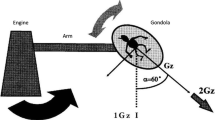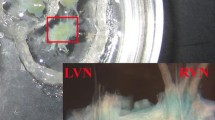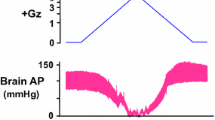Abstract
Cardiovascular functions were studied in semi-arboreal rat snakes (Elaphe obsoleta) following long-term, intermittent exposure to +1.5G z (head-totail acceleration) on a centrifuge. Snakes were held in a nearly straight position within horizontal plastic tubes during periods of centrifugation. Centrifugal acceleration, therefore, subjected snakes to a linear force gradient with the maximal force being experienced at the tail. Compared to non-centrifuged controls,G z-acceimated snakes showed greater increases of heart rate during head-up tilt or acceleration, greater sensitivity of arterial pressure to circulating catecholamines, higher blood levels of corticosterone, and higher blood ratios of prostaglandin F2α/prostaglandin E2. Cardiovascular tolerance to increased gravity during gradedG z acceleration was measured as the maximum (caudal) acceleration force at which carotid arterial blood flow became null. When such tolerances were adjusted for effects of body size and other continuous variables incorporated into an analysis of covariance, the difference between the adjusted mean values of control and acelimated snakes (2.37 and 2.84G z, respectively) corresponded closely to the 0.5G difference between the acelimationG (1.5) and Earth gravity (1.0). As in other vertebrates, cardiovascular tolerance toG z stress tended to be increased by acclimation, short body length, high arterial pressure, and comparatively large blood volume. Voluntary body movements were important for promoting carotid blood flow at the higher levels ofG z stress.
Similar content being viewed by others
Abbreviations
- bpm :
-
heat beats per minute
- FV :
-
fluid volume
- G :
-
gravitational or acceleration force
- G z :
-
gravitational or acceleration force in the head-to-tail direction
- Hct :
-
hematocrit
- HIP :
-
hydrostatic indifferent point
- PGE :
-
prostaglandin E2
- PGF :
-
prostaglandin F2a
- PGFM :
-
stable metabolite of PGF
- RCV :
-
red cell volume
- RIA :
-
radioimmunoassay
- SAS :
-
statistical analysis system
- TBV :
-
total blood volume
References
Burton RR, Smith AH (1996) Adaptation to acceleration environments. In: Fregly MJ, Blatteis CM (eds) Handbook of physiology: Environmental physiology, sec 3. Oxford University Press, New York, pp 943–970
Conklin DJ, Lillywhite HB, Olson KR, Ballard RE, Hargens AR (1996) Blood vessel adaptation to gravity in a semi-arboreal snake. J Comp Physiol 165: 518–526
Donald JA, Lillywhite HB (1988) Adrenergic innervation of the large arteries and veins of the semi-arboreal ratsnake,Elaphe obsoleta. J Morphol 198: 25–31
Dlusskaya IG, Khomenko MN (1985) Responses of subjects differing in tolerances of +G z to tilt tests and water loading tests. Kom Biol Med 19: 22–27
Elsey RM, Joanen T, McNease L, Lance V (1990a) Growth rate and plasma corticosterone levels in juvenile alligators maintained at different stocking densities. J Exp Zool 255: 30–36
Elsey RM, Joanen T, McNease L, Lance V (1990b) Stress and plasma corticosterone levels in the American alligator — relationships with stocking density and nesting success. Comp Biochem Physiol 95A: 55–63
Gauer OH, Thron HL (1965) Postural changes in the circulation. In: Hamilton WF, Dow P (eds) Handbook of physiology, sec. 2; Circulation, vol 3. American Physiological Society, Washington, DC, pp 2409–2439
Guillette LJ Jr, Cree A, Rooney AA (1995) Biology of stress: interactions with reproduction, immunology and intermediary metabolism. In: Warwick C et al. (eds) Health and welfare of captive reptiles. Chapman and Hall, London, pp 32–81
Klein KE, Bruner H, Jovy D, Vogt L, Wegman HM (1969) Influence of stature and physical fitness in tilt-table and acceleration tolerance. Aerosp Med 40: 293–297
Lance V, Lauren D (1984) Circadian variation in plasma corticosterone in the American alligator,Alligator mississippiensis, and the effects of ACTH injections. Gen Comp Endocrinol 54:1–7
Lillywhite HB (1985a) Postural edema and blood pooling in snakes. Am Zool 58: 759–766
Lillywhite HB (1985b) Behavioral control of arterial pressure in snakes. Physiol Zool 58: 159–165
Lillywhite HB (1987) Circulatory adaptations of snakes to gravity. Am Zool 27: 81–95
Lillywhite HB (1988) Snakes, blood circulation and gravity. Sci Am 256: 92–98
Lillywhite HB (1993) Subcutaneous compliance and graviational adaptation in snakes. J Exp Zool 267: 557–562
Lillywhite HB (1996) Gravity, blood circulation, and the adaptation of form and function in lower verterbrates. J Exp Zool (in press)
Lillywhite HB, Donald JA (1994) Neural regulation of arterial blood pressure in snakes. Physiol Zool 67: 1260–1283
Lillywhite HB, Gallagher KP (1985) Hemodynamic adjustements to head-up posture in the partly arboreal snake,Elaphe obsoleta. J Exp Zool 235: 325–334
Lillywhite HB, Henderson RW (1993) Behavioral and functional ecology of arboreal snakes. In: Seigel RS, Collins JT (eds) Snakes: ecology and behavior. McGraw-Hill, New York, pp 1–48
Lillywhite HB, Seymour RS (1978) Regulation of arterial blood pressure in Australian tiger snakes. J Exp Biol 75: 65–79
Lillywhite HB, Smith LH (1981) Haemodynamic responses to haemorrhage in the snake,Elaphe obsoleta obsoleta. J Exp Biol 94: 275–283
Lillywhite HB, Ballard RE, Hargens AR (1996) Tolerance of snakes to hypergravity. Physiol Zool 69: 293–303
McGiff JC (1981) Prostaglandins and blood pressure control. In: Soffer RL (ed) Biochemical regulation of blood pressure, Wiley, New York, pp 359–389
McGiff JC, Malik KU, Terragno NA (1976) Prostaglandins as determinants of vascular reactivity. Fed Proc 35: 2382–2387
Morey-Holton ER, Meulen MC van der, Whalen RT, Arnaud SB (1996) The skeleton and its adaptation to gravity. In: Fregly MJ, Blatteis CM (eds) Handbook of physiology: Environmental physiology, sec 3. Oxford University Press, New York, pp 691–719
Nolan PL, Bentley GA (1978) The effects of sympatholytic drugs on the cardiovascular responses to tilting in anesthetized cats. Clin Exp Pharmacol Physiol 5: 417–427
Pertzoff VA, Britton SW (1948) Force and time elements in circulating changes under acceleration: carotid arterial pressure deficiency area. Am J Physiol 512: 492–498
Rowell LB (1993) Human cardiovascular control. Oxford University Press, New York
Seymour RS, Lillywhite HB (1976) Blood pressure in snakes from different habitats. Nature 264: 664–666
Seymour RS, Hargens AR, Pedley TJ (1993) The heart works against gravity. Am J Physiol 265: R715-R720
Smith AH, Spangler WL, Goldberg JM, Rhode EA (1979) Tolerance of domestic fowl to high sustained +G z. Aviat Space Environ Med 50: 120–125
Smits AW, Lillywhite HB (1985) Maintenance of blood volume in snakes: dynamics of extravascular fluids in response to hypovolemia induced by hemorrhage. J Comp Physiol B 155: 305–310
Tyrrell C (1993) Corticosterone cycles in wild and captive tuatara (Sphenodon punctatus). M.Sc. Thesis, University of Otago
Wassersug RJ, Izumi-Kurotani A, Yamashita M, Naitoh T (1993) Motion sickness in amphibians. Behav Neural Biol 60: 42–51
Watenpaugh DE, Hargens AR (1996) The cardiovascular system in microgravity. In: Fregly MJ, Blatteis CM (eds) Handbook of Physiology: Environmental physiology, sec 3. Oxford University Press, New York, pp 631–674
Wilson BS, Wingfield JC (1992) Correlation between female reproductive condition and plasma corticosterone in the lizardUta stansburiana. Copeia 1992: 691–697
Author information
Authors and Affiliations
Additional information
Communicated by L.C.-H. Wang
Rights and permissions
About this article
Cite this article
Lillywhite, H.B., Ballard, R.E. & Hargens, A.R. Cardiovascular responses of semi-arboreal snakes to chronic, intermittent hypergravity. J Comp Physiol B 166, 241–253 (1996). https://doi.org/10.1007/BF00262868
Accepted:
Issue Date:
DOI: https://doi.org/10.1007/BF00262868




